 |
 |
 |
| |
Mortality and progression to decompensated cirrhosis in chronic hepatitis C patients with liver biopsy confirmed fibrosis in the Chronic Hepatitis Cohort Study (CHeCS)
|
| |
| |
Reported by Jules Levin
AASLD Nov 7-11 2014 Boston
Anne C. Moorman1, Fujie Xu1, Xin Tong1, Stuart C. Gordon2, Loralee B. Rupp2, Mei Lu2, Philip R. Spradling1, Eyasu H.Teshale1, Joseph A. Boscarino3, Vinutha Vijayadeva4, Mark A. Schmidt5, Scott D. Holmberg1, for the CHeCS Investigators
1Division of Viral Hepatitis, CDC, Atlanta; 2Henry Ford Health System, Detroit; MI 3Geisinger Health System, Danville, PA; 4Kaiser Permanente Hawaii, Honolulu, HI; 5Kaiser Permanente Northwest, Portland, OR
"In a large cohort of CHC patients during 2004-2011 prior to the prevalent use of triple therapy, we observed substantial progression to DC, HCC, and mortality among those at higher fibrosis levels despite availability of standard therapy. These findings can help providers in determining the risks of disease progression without DAAbased anti-HCV therapy."......."for F2 (n=810) 3.8% developed DC, 1.0% HCC, and 6.0% died"
F2 Risk for HCC, decompensation, liver transplant, death. I think these risks actually are higher because some F2s advance into F3/F4 so you can't capture some of their further complications until they are in F3/F4 already.
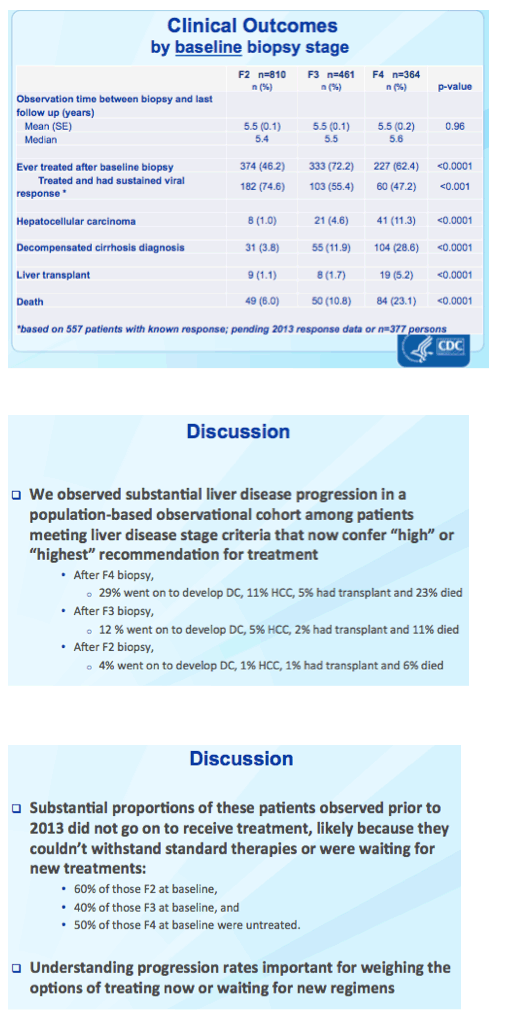
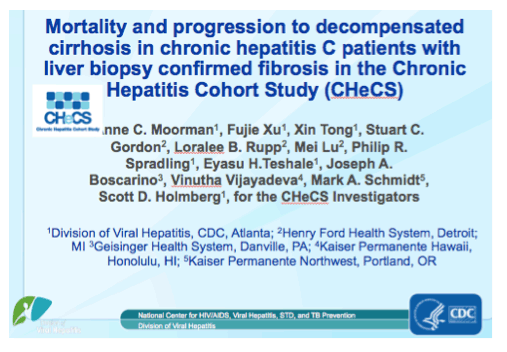
Program abstract
Mortality and progression to decompensated cirrhosis in chronic hepatitis C (CHC) patients with liver biopsy confirmed fibrosis in the Chronic Hepatitis Cohort Study (CHeCS)
Background: CHC patients are at risk for progressive hepatic fibrosis and cirrhosis, leading to hepatocellular carcinoma (HCC) or decompensated cirrhosis (DC); deaths from CHC are increasing in the U.S. Using data from CHeCS, an ongoing observational cohort study among patients of 4 U.S. integrated healthcare systems, we sought to describe all-cause mortality and progression to DC/ HCC among CHC patients following biopsy-confirmed fibrosis in the era prior to direct acting antivirals (DAAs). Methods: For patients with liver biopsies performed during 2004-2011 and before onset of DC, HCC, or HCV therapy, fibrosis scores from different systems were mapped to a F0-F4 equivalency scale. Onset of DC was defined as first occurrence in the following group of conditions identified by ICD9 diagnosis/procedure codes validated as associated with DC in CHeCS: liver transplant, hepatic encephalopathy, portal hypertension, esophageal varices or ascites. HCC was based on validated tumor registry reports. We examined patient demographic and clinical characteristics and used a proportional-hazard model with treatment as time-dependent covariate to estimate risk of developing DC.
Results: Among 14,256 patients eligible for the CHeCS HCV cohort during 2004-2011, 2,110 had qualifying biopsies and of these 616 (29%) had F2 fibrosis, 336 (16%) F3, and 300 (14%) F4.
The proportions of DC, HCC and death were observed over mean/median 4 years in each group (range 3.7-4.2 years): for F2 3.6% developed DC, 1.0% HCC, and 4.9% died; for F3 these were 10.1%/2.7%/10.4% and for F4 were 27.7%/8.3%/23.7%. Ever-receipt of anti-HCV therapy was 64% among F3, 52% among F4, and 41% among F2 patients. Among those treated, SVR was achieved by 46% of F2, 26% of F3, and 23% of F4 patients. In a proportional hazards model, after adjusting for demographic and clinical covariates, factors independently associated with progression to DC included black vs white race (aHR 1.8), initial biopsy stage F3
(aHR 2.4) or F4 (aHR 3.9) vs F2, higher Charlson comorbidity score at any time after biopsy (compared with score of 0, score ≥3 aHR= 3.0, score 2 aHR=2.8, score 1 aHR=1.8), or platelet count normal (aHR 3.4) at the time of biopsy. Receipt of any anti-HCV treatment was protective (aHR 0.7).
Conclusions: In a large cohort of CHC patients during 2004-2011 prior to the prevalent use of triple therapy, we observed substantial progression to DC, HCC, and mortality among those at higher fibrosis levels despite availability of standard therapy. These findings can help providers in determining the risks of disease progression without DAAbased anti-HCV therapy.
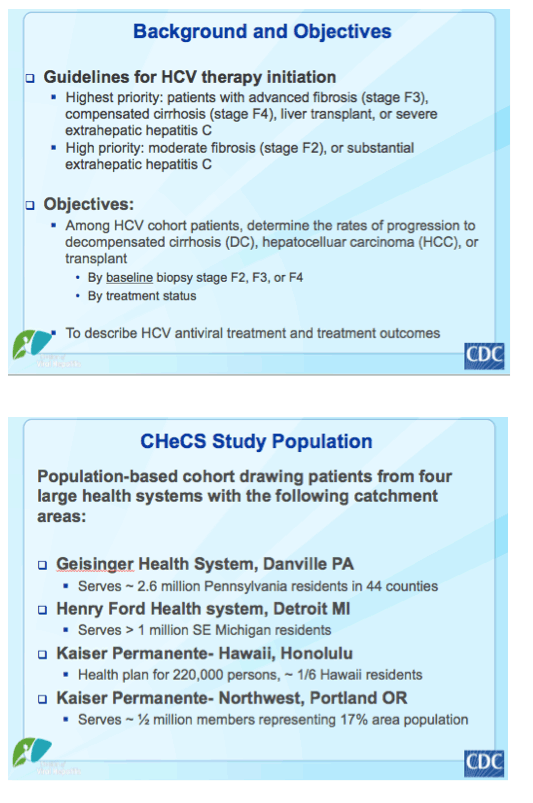
Geisinger Health System (GHS) provides health care services to about 2.6 million Pennsylvania residents, approximately half the residents of 44 rural to moderately urban counties in central and northeastern Pennsylvania. Henry Ford Health System (HFHS) serves more than one million southeast Michigan residents in primarily urban and suburban areas and is one of the three largest providers of health care services in southeastern Michigan. Kaiser Permanente- Honolulu, Hawaii, serves more than 200,000 persons and is the health plan for one-sixth of Hawaiian residents. And last, Kaiser Permanente-Northwest serves over 476,000 members and represents about 17% of the area's population.
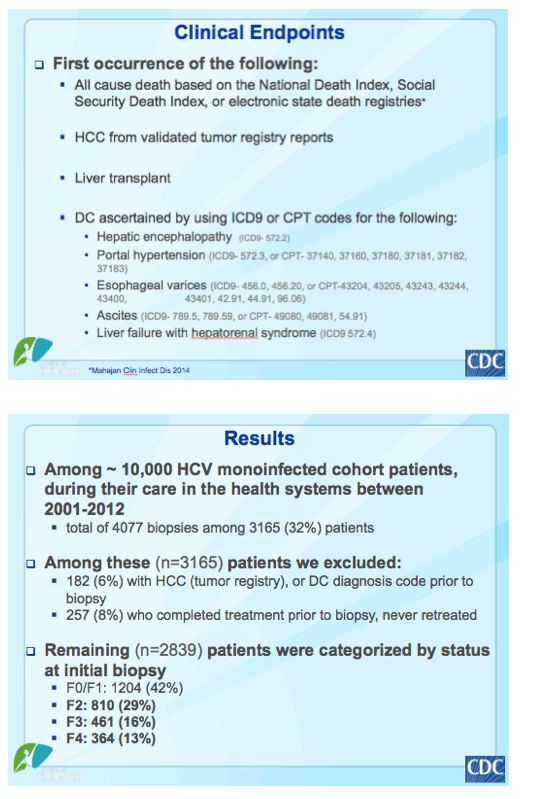
from Jules: since only 13% of subjects were African-American, 56-71% had private insurance & 3 of the 4 sites in this study were non-urban I suggest you would find different results, worst findings in inner cities; indeed, the study abstract says: "factors independently associated with progression to DC included black vs white race (aHR 1.8)"

The patients in the higher biopsy stage groups, not surprisingly, tended to have more comorbidities baseline- serious comorbidities present in slightly more than half of the F4 group
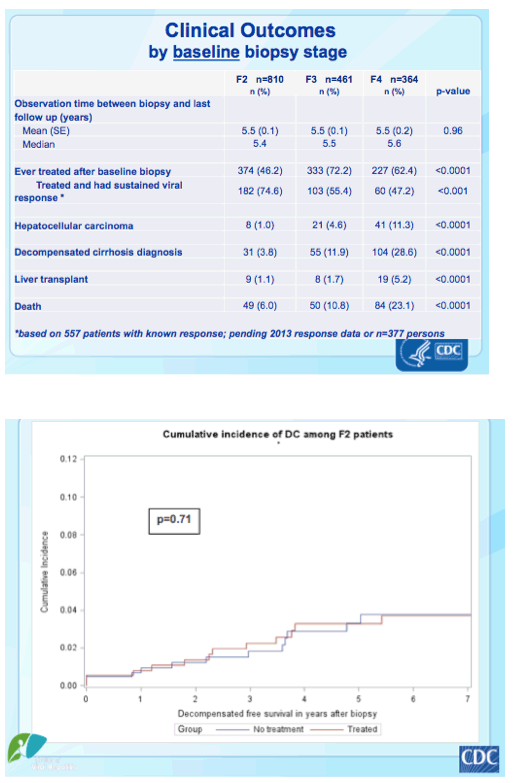
These next few slides show survival curves for the cumulative incidence of HCC or DC in the first 7 years after baseline biopsy, by treatment status for each biopsy stage group. Please keep in mind that for this analysis we defined treatment as having been prescribed one day or more therapy, and we have not broken down the treatment groups by rates of therapy completion or SVR status because of small numbers. In these analyses death or transplant were considered as competing risk. This figure shows the cumulative incidence of DC on the y axis, by year after an F2 baseline biopsy. No differences by treatment status were observed, probably because of the fairly low cumulative incidence, less than 4%. In each case observation is censored at the date of diagnosis of DC or HCC, the date of death, the date of transplant, or the date of last contact, whichever came first.)
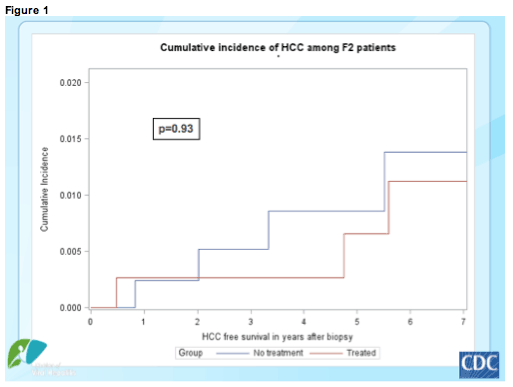
We also saw no difference in incidence of HCC after an F2 biopsy, perhaps again because of the low cumulative incidence rate, under 1.5% (is also very low, at 7 years cumulative still <2% in both groups.)
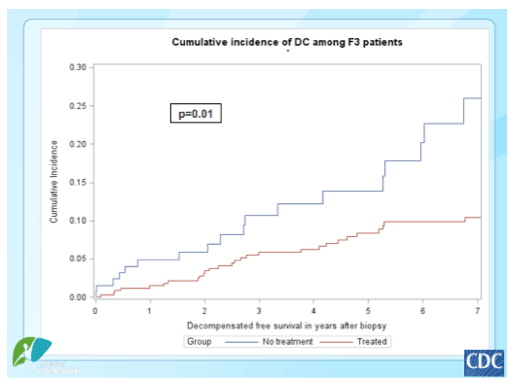
In contrast to the previous figures, we see a substantial difference in cumulative incidence of DC by treatment status after F3 biopsy. Among those untreated more than 25% (1 in 4) patients had developed DC after 7 years vs about 10% in the untreated group.
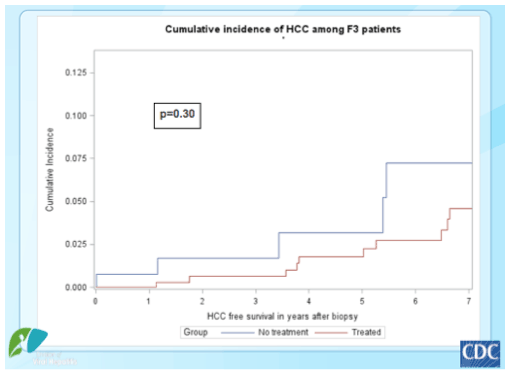
we were unable to discern a significant difference in cumulative incidence of HCC between treatment groups after an F3 biopsy, perhaps due to the relatively small sample size, although more than 7% of untreated patients had developed HCC after 5.5 years of observation
We see a substantial cumulative incidence of DC after an F4 baseline biopsy, with almost half of the untreated patients having developed DC after seven years, in contrast to about a quarter of those who had been treated.
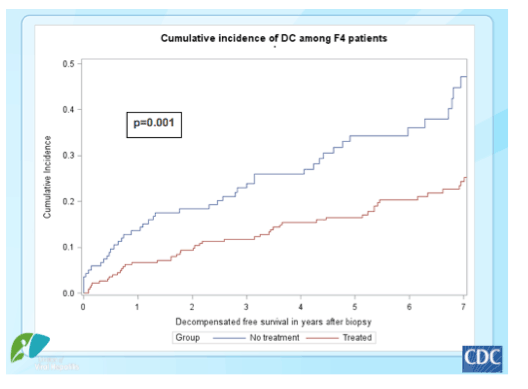
We also saw significant differences in the incidence of HCC between the treated and untreated groups after an F4 biopsy, with an almost doubled incidence of HCC among the untreated patients by 7 years, at close to 15%
Table 4
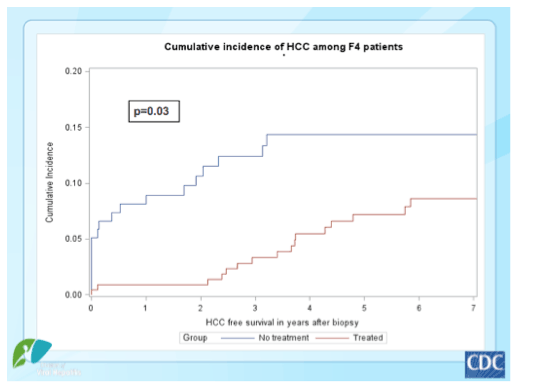
This slide shows the results of a Cox Proportional-hazards model for developing DC among patients at F2, F3 and F4 at baseline. The model was adjusted for factors that included age, race, sex, and baseline ALT as well as those significant associations shown; in addition to biopsy stage at baseline these significant associations included
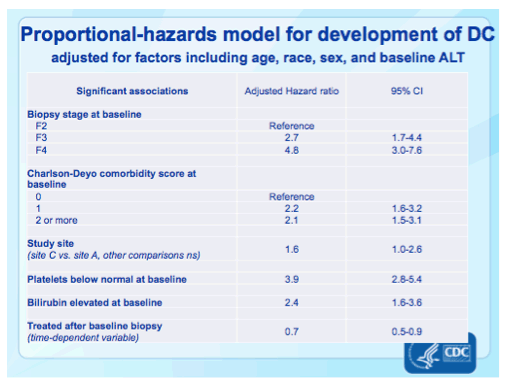
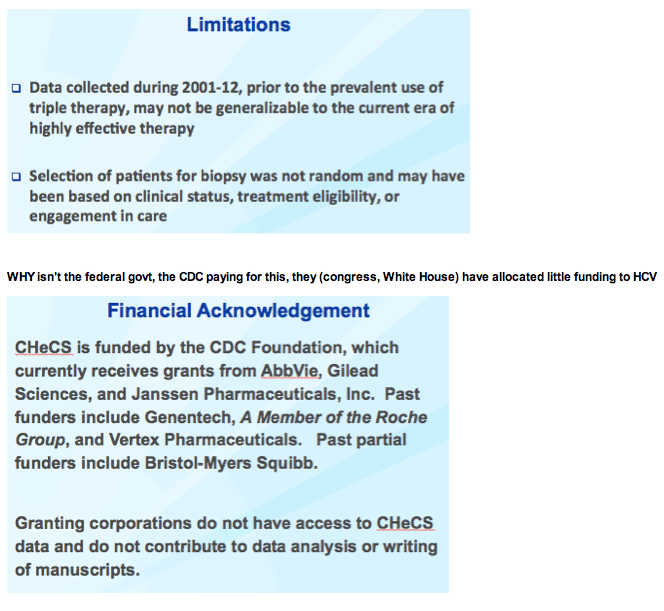
|
| |
|
 |
 |
|
|